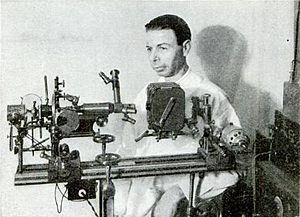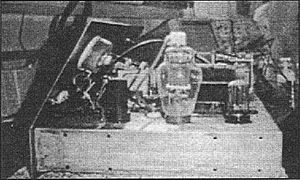Royal Rife facts for kids
Quick facts for kids
Royal Raymond Rife
|
|
|---|---|
 |
|
| Born | May 16, 1888 Elkhorn, Nebraska, United States
|
| Died | August 5, 1971 (aged 83) |
| Nationality | American |
| Occupation | Inventor |
| Known for | Microscopes and Rife’s device |
Royal Raymond Rife (May 16, 1888 – August 5, 1971) was an American inventor. He was known for his work with very powerful microscopes. He also created a special machine that he believed could help treat illnesses.
Rife claimed his microscopes could see tiny living things, like germs, at magnifications no one else could achieve then. He also invented an "oscillating beam ray" device. He thought this machine could destroy disease-causing germs using radio waves. While some scientists and doctors worked with him, his ideas were later rejected. Major groups like the American Medical Association (AMA) and the American Cancer Society (ACS) did not support his claims.
Even today, some people believe that Rife's ideas are correct. They claim that special electromagnetic frequencies can harm cancer cells and other germs. However, most of these claims do not have scientific proof. Health authorities around the world do not approve Rife machines for medical treatment. Some people who promoted these machines have faced legal trouble for making false health claims.
Contents
Rife's Life and Inventions
Not much detailed information is available about Rife's early life and work. In the 1930s, he built several optical microscopes. He even used a movie camera to film tiny microbes over time. He claimed some of his microscopes could magnify things up to 17,000 times or more.
A report from the Smithsonian Institution described one of his microscopes. It said the microscope was very clear and powerful. Several doctors who saw it work were impressed by its high magnification.
However, some things Rife claimed to see with his microscopes are not supported by modern science. For example, he said that typhoid bacteria could change into a much smaller form. He also claimed that most cancer tumors contained a microbe that could change into five different forms. One form looked like E. coli, and another looked like a fungus. Modern science does not agree with these ideas.
Rife also said his "beam ray" device could destroy tiny disease-causing germs. He claimed to find a "Mortal Oscillatory Rate" for different germs. This meant he believed he could destroy them by vibrating them with radio waves at a specific frequency. In 1938, a newspaper reported that Rife did not claim to cure cancer. Instead, he said he could "devitalize disease organisms" in living tissue. In 1931, Rife warned people about "medical fakers" who claimed to cure diseases with "electrical 'vibrations'." He stated his own work was different from such claims.
Rife passed away on August 5, 1971, at the age of 83. An obituary said he died without much money and was sad that his devices were not accepted by science. Rife believed that major medical groups had unfairly rejected his work.
Health Claims After Rife's Death
Interest in Rife's ideas grew again after a book was published in 1987. The book claimed Rife had found a cure for cancer, but that powerful groups had hidden his work. The American Cancer Society (ACS) said these claims were not believable. They noted the book sounded like a "conspiracy theory."
After this book, many devices named after Rife were sold. They were advertised as cures for many diseases, including cancer and AIDS. One analysis found that a typical "Rife device" was very simple. It had basic electrical parts and produced a small electrical current. Its design was similar to another device called a "zapper," not Rife's original machines. These devices were sold at very different prices, from hundreds to thousands of dollars.
These "Rife devices" have been part of several cases of health fraud in the U.S. People often made big claims about what the devices could do, but they were useless. In one case, people selling a "Rife device" were found guilty of health fraud. The judge said they targeted "the most vulnerable people," including those with serious illnesses. Sadly, some cancer patients stopped their regular treatments and used these devices instead, which led to their deaths.
In Australia, the use of Rife machines has been linked to the deaths of cancer patients. These patients might have been cured with standard medical treatments. In 2002, a man who ran the Royal Rife Research Society was sent to prison for selling Rife devices illegally. In 2009, another person was found guilty of selling Rife devices under different names. Mainstream experts today consider Rife devices to be a form of pseudomedicine, meaning they are not based on scientific evidence.
Rife's Legacy and Modern Views
In 1994, the American Cancer Society's journal criticized Rife's methods and devices. They reported that Rife machines were being sold in a way similar to a pyramid-like marketing plan. A key part of selling Rife devices has been the claim that a powerful group was trying to hide their benefits.
Even though "Rife devices" are not approved by the U.S. Food and Drug Administration (FDA) and have been linked to deaths, many people still attend conferences about them. For example, in 2006, over 300 people went to a Rife conference in Seattle. Many unapproved devices were sold there.
Cancer Research UK, a large cancer research charity, has stated: "There is no reliable evidence that the Rife machine works as a cure for cancer... There is also no evidence that it doesn't cause harm... No reputable scientific cancer organizations support any of these claims."
A newspaper article in 2000 warned that "Cancer sufferers have died after putting their faith in a device with electrical parts worth just $15." The article also reported that Rife machines are "unanimously condemned as worthless by mainstream scientists." They are also banned in at least two American states.
See also
 In Spanish: Royal Rife para niños
In Spanish: Royal Rife para niños
- Electromagnetic therapy (alternative medicine)
- List of ineffective cancer treatments
- Medical applications of radio frequency
- Pulsed radiofrequency#Therapeutic uses



